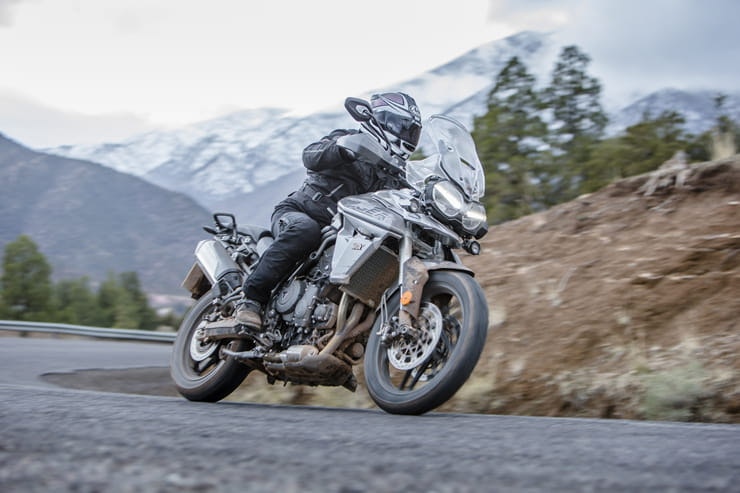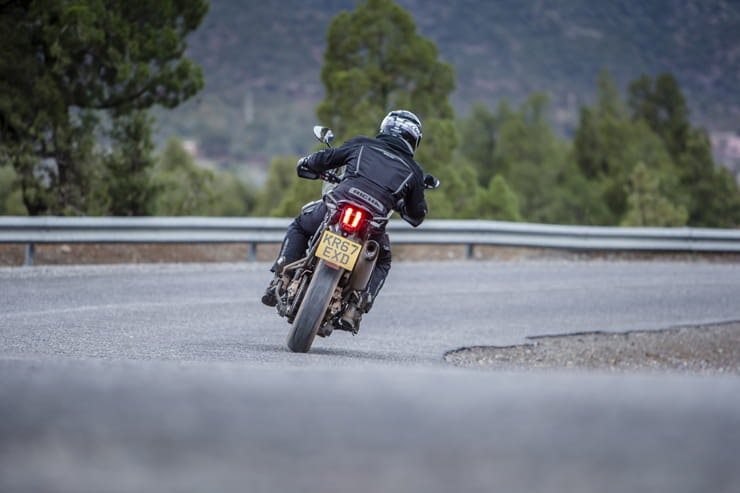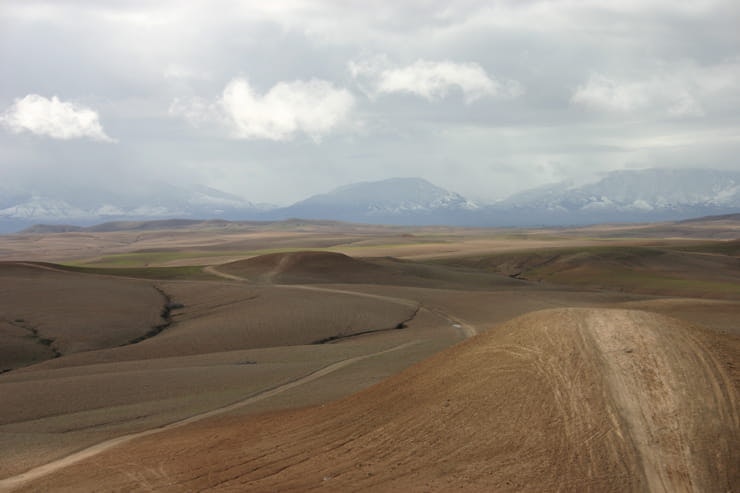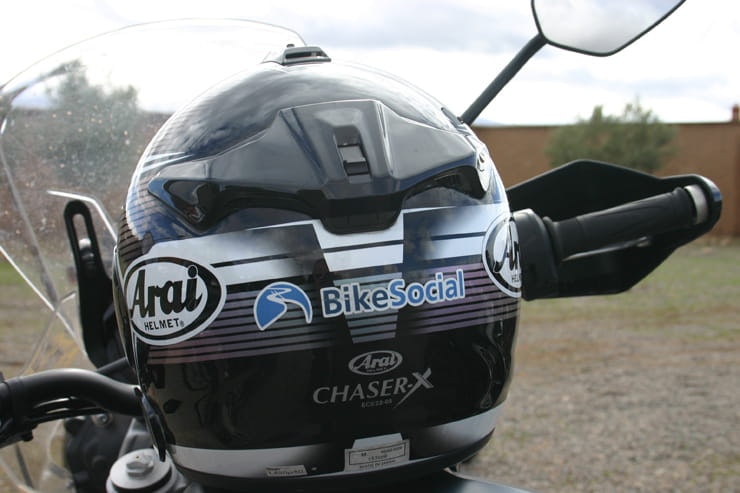Triumph Tiger 800 (2018) | First ride and Review
By Simon Hancocks
Motorcycle Journalist
09.02.2018
KIT CREDITS
Jacket
Richa Atacama | £499.99
Trousers
Richa Cyclone | £329.99
Boots
TCX Drifter | £259.99
Gloves
Furygan Sparrow | £89.99
As someone who only passed my test last spring, the thought of jumping on a 100hp motorcycle and flinging myself across a desert was a daunting one. My previous new bike launches were guided rides along stunning roads in Spain, this one, Triumph’s heavily-revised Tiger 800 was a proper two-day affair in Morocco. Day one spent on-road riding the £12,050 top-spec Tiger 800 XRT, day two in the sand dunes riding the £12,450 range-topping off road version, the Tiger 800 XCA.
Triumph Tiger 800 (2018) | Review
BikeSocial went to Morocco to sample Triumph's revised middle weight adventure bike.
Triumph Tiger 800 XRT | Day 1
Equipment
The flag ship of the road biased Tiggers is almost as fully loaded with electronics as a 200bhp superbike. The riding modes cover: Road, Rain, Off-Road, Sport and Rider which is a custom mode that allows you to configure the traction control (TCS) and ABS to your needs. The XRT, XCX and XCA all have adjustable suspension, Showa on the XRT and WP on the XCX and XCA. You have a full TFT dash with switchable styles, LED lights from front to back, heated grips and heated rider and passenger seats and backlit switches
Travel tip: If you are looking for swathes of perfect tarmac to scratch about on, steer clear of Lalla Takerhoust. The region is about 60-miles north of Marrakech and seems to be the land that health and safety forgot! The roads are rutted, slippery and in some places non existent. So most of my time was spent flicking through the riding modes to suit the surface. You make your selection using the five direction joystick on the left handlebar and the display clearly tells you which mode you selected. The riding modes are distinctly different and alter the amount of TCS and ABS intervention and it is genuinely noticeable. The Rain mode softens the power-curve, handy for navigating the endless hairpins that lay two-inches beneath rivers of muddy rain water. Sport is a more aggressive map which, if you were touring in the dry would make the most sense. The riding modes are easy to change between but I did find it I’d mistakenly flick the indicator instead of the joystick from time to time.
The joystick is to select the riding mode and is easily mistaken for the indicators!
Morocco in winter is, er, cold. And wet. The heated grips and seats were permanently on the highest setting and they worked faultlessly. I find, with any heated kit, the initial blast of heat quickly dims but the Tigers grips and seat gave a constant and comforting warmth that made riding through a blizzard on top of the Atlas Mountains that little bit less painful.
Chassis and Suspension
On the stretches of road that weren’t potholed and eroded I stretched the legs of the Tiger as much as I dared and found it to be composed and neutral, with all the comfort, fuel economy, luggage carrying ability and two-up potential I could imagine needing in an adventure bike. The Showa adjustable front and rear suspension soaked up everything North Africa could throw at it, including a four-mile detour, when the designated route had been washed away. So the road-biased Tiger XRT with its firm suspension and road tyres was pointed up a mud-track going up and over a mountain - four miles is a long way when there’s a mountain involved. With Off-Road mode selected the bike now had less TCS but full ABS to the front and no ABS to the rear; it was still tricky but it was ride-able. The limiting factor was the road tyres, which clogged with mud, wiping out all grip.
The twin Brembo calipers and 305mm front discs are plenty powerful enough for general commuting and touring. They provided enough bite to have the bike’s nose diving for the tarmac when the crash-test donkeys wandered across the road, yet were progressive enough to need just two fingers.
Engine and Gearbox
The 12-valve 800cc triple makes 94bhp at 9,500rpm and 79Nm of torque at 8,050rpm. The engine revs freely, hiding that grunt behind a very flat torque curve. There’s no shove in the back like a twin, instead, it picks up and spins like a torquey four-cylinder and feels quicker than a sub-100bhp tourer should. For best aural satisfaction; dropping a couple of gears and hitting the rev-limiter means overtakes are dispatched quickly and with a wonderful bark from the revised and lightened exhaust system.
The six speed gearbox includes a new-for-2018 short ratio first gear. The change is crisp and precise with the new first cog that makes tight turns and weaving through traffic a breeze. In Sport mode, with the sharpest throttle response and lowest TCS setting, you could just feel the front start to lift when you pulled away aggressively. Not in a way that’d scare a new rider but enough to keep a more experienced pilot entertained.
During the road ride I saw about 50mpg on the bikes on-board computer which, for a press ride, is very good. I reckon if I was riding the Tiger on my normal route to work, A14 – M6, I’d see a much higher figure.
Heated rider and passenger seats were fantastic, a great option if you ride all year
Comfort
The XRT has an adjustable seat that takes it from 810mm to 830mm. On it’s lowest setting I (dreaming of a final growth spurt to hit six foot) found it comfortable to get on and off and secure enough when stopping on uneven and broken surfaces. The bars were well positioned, the switchgear was within easy reach and after a day in the saddle I had no aches or pains to report. The waist of the Tiger is fairly narrow and it put no undue pressure on my hips but the pegs on the XRT are rubber clad affairs. Some light rain and a splash of mud had me slipping about in my adventure boots. If I was going to buy one, I’d upgrade to the CNC machined bear-trap footpegs from the Triumph options list. For those that need something lower than 810mm, check out the XRX Low – bespoke chassis and suspension changes mean a 760mm to 780mm seat height. As a commercial move from Triumph, this is genius and should really open up this sector to people that previously wouldn’t be able to ride this kind of adventure/touring bike.
Morocco is a bucket list destination for the budding adventure motorcyclist
Triumph Tiger 800 XCA | Day 2
Off-road
As a complete novice to off-road riding, day two had me slightly worried. At breakfast I found out I was in the advanced group, led by Dakar racer Nick Plumb and Felipe Lopez, rider of Triumph’s awesome Tramontana project. My worry turned to blind panic!
Thankfully Triumph had tricked out the top-spec off-road version of the Tiger and fitted it with knobbly Pirelli Scorpion Rally tyres. With the bars adjusted, to allow more out of the seat riding and softer suspension settings, the bikes looked at home in the mountainous surroundings.
With about eight miles of road before the trails began I put the XCA through its paces and was thinking you’d have to do a lot of off-roading to buy this as your only bike. It’s good on the road but compromised by the longer-travel suspension. You could either change the settings on the fully adjustable WP suspension or learn to love the slightly wallowing ride. Then we arrived at the dunes.
Stunning would be an understatement. On day one we rode through snow covered villages where barefoot children ran out to greet us. Today it looked more like the film set of Star Wars. Nothing but rolling dunes, with Morocco’s highest mountain, the 13,000-foot-tall Toubkal, watching my every move – I’d never felt further from my comfort zone.
As the trails disappeared and the sand became deeper the Tiger got better and better. The upgraded WP suspension, unique to the XCX and XCA versions, came into its own on the uneven rocky terrain. The only time there was a hint of the suspension bottoming out was dropping down a steep descent into a dry(ish) riverbed and landing heavily on the front wheel. Even then, the rebound damping settled quickly meaning I could get on with task of not falling off. Sadly, at that moment I ran out of talent. And fell off. It was nothing to do with the bike; the primordial ooze at the bottom of the ‘dry’ riverbed was a foot deep and concealed a football sized boulder that spat the handlebars in one direction and sent me in the other.
Once the assembled press and pro-riders had finished applauding and laughing, Filipe (pro off road rider and Tramontana racer, remember?) helped me retrieve my bike. It’s worth noting that at 5’7” and fairly fit, I couldn’t lift the bike alone. I’m not sure if it was the soft sand or two hours desert riding and a lifetime of crafty smoking.
Filipe ran back to his bike, rode up to meet us, only to fall at exactly the same spot. This was either completely genuine or he did it to make me feel better. I’m thinking the latter!
The only real negative I have about the XCA is that most of the riding we had to do required the bike's special Off-Road Pro mode. In this setting you have no TCS and no ABS front or rear, allowing you to use all of the 94bhp to spin the back wheel on loose surfaces - essential on the steepest hills. The problem was, when you stopped and turned the bike off to have a drink or take some photos, the system would put you back into the Road Mode. This meant we either had to navigate the menus again before setting off or stop the engine on the kill switch, thus leaving the bike on the Off-Road mode ready for the next section.
On some of the faster more flowing stretches I’d flick the bike into the Off-Road mode instead of Off-Road Pro. Now the ABS to the rear is still disabled but there is ABS to the front wheel, just to a lesser degree than the road setting. You still have TCS but it allows a much greater amount of wheel spin before intervening. On the steepest hills you don’t want the TCS to cut in and slow your progress but at 75mph on loose gravel and sand, a rear wheel spinning at full chat could mean a high-side; especially for a newbie like me. The Off-Road mode allowed me to slide the back end out under acceleration enough to feel like a hero yet it cut in at just the right moment bringing it all under control again. I was stunned by how well it worked, at any speed. Out of slow corners the system allowed the bike to get really sideways before cutting in and at 50mph plus it reduced the angle of slide but still brought a massive grin to my face. And it kept me out of the rescue helicopter, which was nice.
Verdict
I think the biggest plaudit I can give the new Tiger 800 is that it allowed me, a complete novice to off-road riding, to hurtle through the desert at 80mph with a group of extremely experienced journalists and two professional off-road riders. Lead rider: Nick Plumb is the youngest Brit to finish the Dakar rally and is the Triumph Off Road School boss. While Felipe Lopez came second in the PanAfrica Rally in the Maxi-Trail class this year aboard Triumph’s Tramontana project. I know it wasn’t a competitive event, I’m not looking for a Blue Peter badge or anything but, those guys all have more experience than me, more skill than me and probably bigger balls than me. But, I did every obstacle they did, climbed every slope they climbed and navigated every river bed they conquered. Yes, I did fall off but I wasn’t the only one… I probably am the only who will admit it though!
Riding photos and video by Kingdom Creative - Edited by Beach Media
Triumph Tiger 800 Technical Specification
Engine
Chassis
Dimensions



